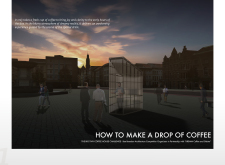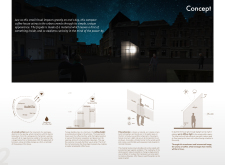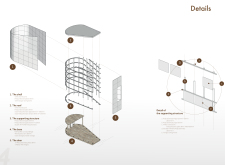5 key facts about this project
The coffee house features a curved exterior, working against the backdrop of straight-edged urban architecture. This contrast not only distinguishes the building but also acts as an invitation to engage with the space. The overall design prioritizes functionality while maintaining an appealing visual aesthetic.
Unique Material and Construction Techniques
The project employs polycarbonate as the primary material, selected for its properties of translucency, durability, and sustainability. The use of polycarbonate plates and pipes allows natural light to permeate the building while ensuring resistance to weathering. This choice of material enhances the quality of light within the coffee house, creating a warm and inviting ambience. The structural design, utilizing interlocking polycarbonate components, is central to its stability and lightweight characteristics, which allows for an efficient assembly process.
This architectural design also utilizes recycled wood for its base, reinforcing the project's commitment to sustainability. By using existing materials, the project minimizes waste and aligns with contemporary best practices in architectural design. The integration of these materials reflects an intentional approach to create a responsible and environmentally conscious structure.
Functional Zoning and Layout
The interior layout is carefully planned to facilitate both customer experience and barista efficiency. Designated areas include a workspace for baristas, a seating area for customers, and storage solutions that promote an organized environment. The zoning of spaces is strategically differentiated through varying ceiling heights, with the workspace designed for ease of movement and the customer area crafted for comfort.
Efficiency in the layout not only enhances the operational flow but also creates a welcoming atmosphere that invites patrons to linger. This dual focus on function and user experience is key to the architectural identity of the coffee house.
The design incorporates dynamic spatial relationships, with the placement of windows and openings enhancing the connection between indoor and outdoor environments. Customer movement is guided intuitively from the exterior to the interior, promoting interaction with the surrounding urban context.
For those interested in further details, exploring the architectural plans, sections, and additional design elements will provide greater insights into the thoughtful decisions behind this coffee house project. Engaging with these materials can enhance understanding of the architecture and its role in fostering social connections within public spaces.


























